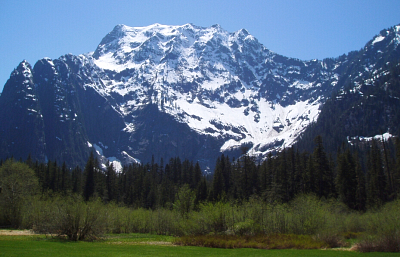Big Four Mountain - Dry Creek Route (attempt), June 2006

Big Four is well known around these parts for two reasons: the stupendous North Face and the ice caves at the foot of the North Face. The North Face is plainly visible from Mountain Loop Highway at several locations and from the viewpoint/picnic area near the highway. This face is 4,000 ft high. It rises like a palisade from the ice caves in a series of high-angle ribs and gullies. The ribs rise up to form five distinct nubs that look like brass knuckles. Indeed the symbolism is apt, for there is no easy way to the top of this peak and you might be punished for trying. Interestingly, the mountain does not take its name from the knuckles on its summit crest (there are five knuckles, not four). Instead, it apparently got its name from the giant "4-shaped" snowpatch on the East Face, which I've never seen. The peak is everywhere rugged. The easiest route is from the east (from Dry Creek). The North Face relents with difficult ice climb routes but it is generally avoided in summer (loose rock). The NE Ridge contains a hard rock route called the Tower Route.
The ice caves have been a tourist trap for years. An inn was even built at where the present Big Four viewpoint is located. The caves have melted back quite a bit over the years but they are still worthy of a visit (especially since the approach trail is short). What are the ice caves, then? Essentially, there is an avalanche debris cone that forms (or has formed over the centuries) at the base of the North Face. This cone is known as "Rucker's Glacier." Waterfalls plummeting down the face enter at the back of the cone and subsequently flow under it. The water eventually exits at the base of the cone in a series of streams. The combination of ground surface heating characteristics and airflow has excavated large tunnels under the base of the cone. To enter these tunnels is quite dangerous (people have been killed when caves collapse), but they are pretty interesting. People have been known to ice climb near the mouth of the caves or on isolated ice blocks nearby. Walking perpendicular to the caves, one might also encounter temperature variability in the breeze that flows out from the caves - warm, then cool, then warm again...much like the constructive/deconstructive sound wave effects of a good pair of stereophonic speakers. (more...)
Click here to view photos.








